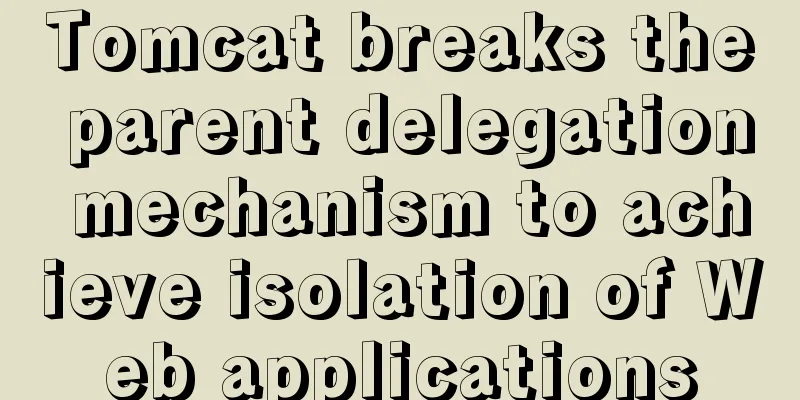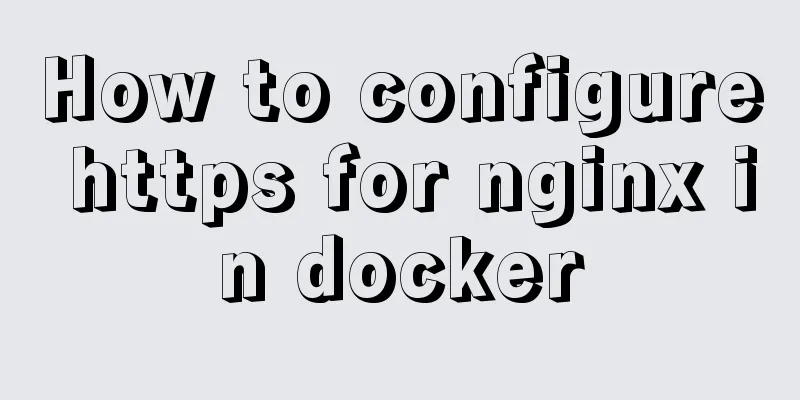Tomcat breaks the parent delegation mechanism to achieve isolation of Web applications

|
Tomcat breaks parent delegation through the custom class loader WebAppClassLoader, that is, it rewrites the findClass method and loadClass method of the JVM class loader ClassLoader to give priority to loading classes in the Web application directory. Tomcat is responsible for loading our Servlet class and the JAR package that the Servlet depends on. Tomcat itself is also a Java program, so it needs to load its own classes and dependent JAR packages. If you run two web applications on Tomcat and they have Servlets with the same name but different functions, Tomcat needs to load and manage these two Servlet classes with the same name at the same time to ensure that they do not conflict. Therefore, classes between Web applications need to be isolated If two web applications both depend on the same third-party jar, such as Spring, then after the Spring jar is loaded into memory, Tomcat must ensure that the two web applications can share it, that is, the Spring jar is only loaded once. Otherwise, as the number of third-party jars increases, the JVM's memory will be too large. Tomcat class loader hierarchy Tomcat's class loader hierarchy
The first three are loader instance names, not class names.
WebAppClassLoader If you use the JVM's default AppClassLoader to load a Web application, AppClassLoader can only load one Servlet class. When loading a second Servlet class with the same name, AppClassLoader returns the Class instance of the first Servlet class. Therefore, Tomcat customizes a class loader WebAppClassLoader and creates a WebAppClassLoader instance for each web application. Each Web application's own Java classes and dependent JAR packages are placed in The Context container component corresponds to a Web application. Therefore, each Context container creates and maintains a WebAppClassLoader loader instance. SharedClassLoaderHow can two web applications share library classes and not load the same class repeatedly? Each child loader of the parent delegation mechanism can load classes through the parent loader, so consider putting the classes to be shared in the loading path of the parent loader. This is how applications share JRE core classes. If WebAppClassLoader does not load a class, it entrusts the parent loader SharedClassLoader to load the class. SharedClassLoader will load the shared class in the specified directory and then return it to WebAppClassLoader to solve the sharing problem. CatalinaClassLoaderHow to isolate Tomcat's own classes from the web application's classes? Sibling relationship: Two class loaders are parallel. They may have the same parent loader, but the classes loaded by the two sibling class loaders are isolated. Therefore, Tomcat created CatalinaClassLoader to load Tomcat's own classes. The question is, what should we do when some classes need to be shared between Tomcat and various web applications? CommonClassLoader Sharing still relies on the father-son relationship. The classes that CommonClassLoader can load can be used by CatalinaClassLoader and SharedClassLoader, while the classes that CatalinaClassLoader and SharedClassLoader can load are isolated from each other. WebAppClassLoader can use classes loaded by SharedClassLoader, but each WebAppClassLoader instance is isolated from each other. Spring loading problem By default, if a class is loaded by class loader A, the dependent classes of the class are also loaded by the same class loader.
public static Class<?> forName(String className) {
Class<?> caller = Reflection.getCallerClass();
return forName0(className, true, ClassLoader.getClassLoader(caller), caller);
}
The caller, Spring's loader, will be used to load the business class. JAR files shared between web applications can be loaded by SharedClassLoader to avoid repeated loading. As a shared third-party jar, Spring is loaded by SharedClassLoader. Spring also needs to load business classes. According to the previous rule, the class loader that loads Spring will also be used to load business classes. However, the business classes are in the Web application directory, not in the loading path of SharedClassLoader. What should I do? Thread context loaderSo there is a thread context loader, a class loader transfer mechanism. Because the class loader is stored in the thread private data, as long as it is the same thread, once the thread context loader is set, the class loader can be taken out and used in the subsequent execution of the thread. Therefore, Tomcat creates a WebAppClassLoader class loader for each Web application and sets the thread context loader in the thread that starts the Web application. In this way, Spring takes out the thread context loader at startup to load the Bean. The code for Spring thread context loading is as follows: cl = Thread.currentThread().getContextClassLoader(); In the startup method of StandardContext, the context loader of the current thread is set to WebAppClassLoader.
At the end of the start method, the thread's context loader is restored: Thread.currentThread().setContextClassLoader(originalClassLoader);
The thread context loader is actually a private data of the thread, which is bound to the thread. After the thread completes starting the Context component, it will be recycled to the thread pool and then used to do other things. In order not to affect other things, the previous thread context loader needs to be restored. The thread context loader specifies the subclass loader to load a specific bridge class, such as the JDBC Driver. SummarizeThe Tomcat Context component creates a WebAppClassLoader class loader for each Web application. Since the classes loaded by different class loader instances are isolated from each other, the purpose of isolating Web applications is achieved. At the same time, third-party JAR packages are shared through parent loaders such as CommonClassLoader. How does a shared third-party JAR package load classes for a specific web application? This can be solved by setting the thread context loader. Java class files and JAR packages shared by multiple applications are placed in the shared directories specified by the Web container: CommonClassLoader CatalinaClassLoader SharedClassLoader WebAppClassloader You can configure the loading paths of various class loaders in the Catalina.properties file in the Tomcat conf directory. When a ClassNotFound error occurs, you should check that your class loader is correct. This is the end of this article about how Tomcat breaks the parent delegation mechanism to achieve isolated Web applications. For more relevant content about Tomcat isolated Web applications, please search for previous articles on 123WORDPRESS.COM or continue to browse the following related articles. I hope you will support 123WORDPRESS.COM in the future! You may also be interested in:
|
<<: How to solve the problem of invalid left join in MySQL and the precautions for its use
>>: Six tips to increase web page loading speed
Recommend
JavaScript implementation of verification code case
This article shares the specific code for JavaScr...
Detailed explanation of Promises in JavaScript
Table of contents Basic usage of Promise: 1. Crea...
A brief discussion on the optimization of MySQL paging for billions of data
Table of contents background analyze Data simulat...
Record the steps of using mqtt server to realize instant communication in vue
MQTT Protocol MQTT (Message Queuing Telemetry Tra...
js realizes two-way data binding (accessor monitoring)
This article example shares the specific code of ...
JavaScript implements click toggle function
This article example shares the specific code of ...
Pure CSS to achieve three-dimensional picture placement effect example code
1. Percentage basis for element width/height/padd...
How to install MySQL under Linux (yum and source code compilation)
Here are two ways to install MySQL under Linux: y...
How to use geoip to restrict regions in nginx
This blog is a work note environment: nginx versi...
Detailed explanation of how to use structural pseudo-class selectors and pseudo-element selectors in CSS3
Introduction to structural pseudo-class selectors...
Example of how to display a default image when an image does not exist in HTML
An image link <img src="" /> I wa...
Instructions for using the database connection pool Druid
Replace it with the optimal database connection p...
VMware vCenter 6.7 installation process (graphic tutorial)
background I originally wanted to download a 6.7 ...
Detailed explanation of how MySQL (InnoDB) handles deadlocks
1. What is deadlock? The official definition is a...
Vue implements the frame rate playback of the carousel
This article example shares the specific code of ...












